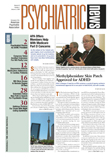A “collaborative care” model that includes telephone-based monitoring and follow-up significantly reduced symptoms of anxiety and depression in primary care patients with panic and generalized anxiety disorder.
Patients who were randomly assigned to a telephone-based, care-management intervention reported reduced anxiety and depression at 12-months, improved mental health related quality of life, and greater improvements over baseline in hours worked per week, compared with patients who received usual care in the primary care setting.
They also had fewer work days absent, according to a study in the December 2005 Archives of General Psychiatry. Lead author Bruce Rollman, M.D., M.P.H., told Psychiatric News that the study also found that the intervention resulted in fewer trips to the emergency room. “It doesn't take a lot of visits to the emergency room to pay for this intervention,” he said.
Rollman is an associate professor of medicine and psychiatry at the University of Pittsburgh School of Medicine.
“The study is the first to report the impact of treating anxiety on work outcome and health-services utilization,” he said. “This is important because we have an employer-based health care system, and employers want to know if their employees are productive.
“With our collaborative care intervention we found a reduction in anxiety and an improvement of quality of life,” he said. “We also found that patients randomized to the intervention were significantly more likely to be working at 12-month followup, had missed fewer days of work, and had worked more hours per week than patients randomized to usual care.”
In the study, investigators used the brief, self-administered Patient Questionnaire portion of the PRIME-MD instrument to screen patients aged 18-64 at four primary care sites for the presence of anxiety symptoms between July 2000 and April 2002. The four sites were all affiliated with the University of Pittsburgh Medical Center and were connected by an electronic medical record-keeping system.
Those who screened positive were then administered the PRIME-MD Anxiety Module to determine if they met DSM-IV criteria for panic disorder or generalized anxiety disorder.
Finally, those patients who met these criteria were given the Hamilton Anxiety Rating Scale and the seven-item Panic Disorder Severity Scale (PDSS). All study-eligible patients with panic disorder scored 7 or higher on the PDSS or had generalized anxiety disorder alone or comorbid with panic disorder and scored 14 or higher on the Hamilton Anxiety Rating Scale.
A total of 191 patients were recruited. Of those, 116 were randomly assigned to the telephone-based care-management intervention, and 75 were assigned to usual care. “Usual care” entailed only notifying the patient and primary care physician of the diagnosis.
The intervention, not unlike the “disease management” strategies used by some health insurance plans, employed nonspecialist“ care managers” who telephoned patients to conduct a detailed mental health assessment, provide basic psychoeducation about panic disorder and generalized anxiety disorder, and ascertain patients' treatment preferences.
Patients could choose one or any combination of the following three treatment options: a workbook with self-management skills and follow-up by care managers to review lesson plans; a guideline-based trial of anxiolytic pharmacotherapy to be prescribed by the primary care physician; or referral to a community mental health specialist.
Based on those preferences, a treatment recommendation was made to the primary care physician, who was free to accept or reject recommendations.
Eighty percent of the intervention patients chose the self-management workbook. And approximately 80 percent of intervention patients used an SSRI/SNRI, with no significant difference at 12 months in use of pharmacotherapy between the intervention group and the usual care group. Approximately 18 percent of intervention patients saw a mental health specialist, compared to 26 percent in the usual care group.
“Patients in the intervention used both the workbook and meds, and some also accepted referral to a mental health specialist,” Rollman said.
Throughout the follow-up period, care managers telephoned patients in the intervention group at regular intervals to promote adherence to whatever treatment they were receiving and monitor progress.
At the 12-month follow-up, intervention patients also experienced greater reductions in depression scores on the Hamilton Rating Scale for Depression and were more likely to experience a 40 percent or greater reduction in depressive symptoms. Usual care patients were significantly more likely to report two or more visits to the emergency room than were intervention patients.
Rollman told Psychiatric News that the collaborative care model used in the study can be used in primary care settings that do not have electronic medical record keeping, though communication with primary care physicians will require faxing and telephone calling.
“These models are spreading,” he said. “We believe these results are meaningful, especially with regard to utilization of health services, and we need to make the case to the people who are paying the bills as to why these conditions are important to treat.”
Arch Gen Psychiatry 2005 62 1332
